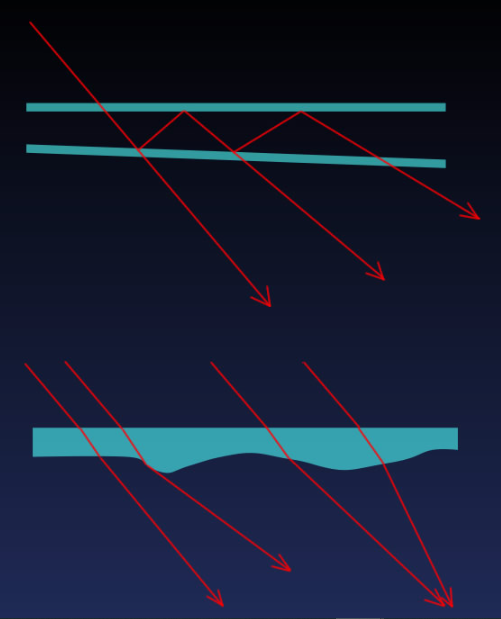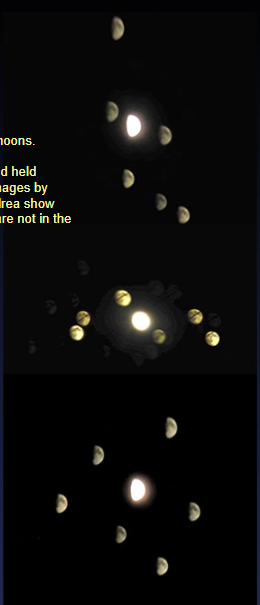Multiple images through glass - OPOD
Multiple Images through Glass: A Deceptive Phenomenon
When observing the sky through glass, one might be surprised to see multiple images of celestial objects. These images, often mistaken for mirages or other peculiar phenomena, can be intriguing and puzzling. In this article, we will delve into the fascinating world of multiple images through glass and explore the science behind this optical illusion.
Exploring the Formation of Multiple Images
To understand how multiple images form through glass, let's consider an example provided by Robin Andrea. In one of her windows, there are four panes of glass, and when a slider panel is moved over the middle section, she deliberately photographed the moon through all four panes. The result? Multiple images of the moon.
It is important to note that when unusual effects appear in photographs, they should not be hastily dismissed. To determine if these effects are real, it is recommended to take at least two additional images with a handheld camera. If the effects remain in the same position and are visible to the naked eye, there is a possibility that they are genuine.
The Influence of Tilted Glass Panes
One factor that contributes to the formation of multiple images through glass is the presence of slightly tilted glass panes. When the panes are not perfectly aligned, a series of ghost images may appear, displaced at multiples of the tilt angle. These ghost images become weaker as their displacement increases, making them more visible for brighter objects.
It is worth mentioning that the tilt of the glass panes may not be uniform across the entire window. Variations in tilt from one area to another can create an uneven distribution of ghost images. To experience this phenomenon firsthand, simply move your head or camera while observing the scene through the glass, and you will quickly notice the illusion.
Lens Elements and Filters: Unveiling Illusions in Photography
The effects observed through glass are not limited to windows alone. Even in photography, tilted filters or plane elements within a lens can produce similar optical illusions. By introducing slight tilts or unevenness, these elements can generate multiple images and distort the appearance of the captured scene.
Refraction and Internal Reflections: Multiplying the Illusion
When light passes through uneven glass, it undergoes refraction, bending at different angles depending on the tilt and wedge angle of the prisms formed within the glass. This refraction, coupled with internal reflections, further multiplies the number of images observed. The combination of these phenomena can create a visually striking and perplexing experience for observers.
Beyond Celestial Objects: Exploring Strange Sightings
While multiple images through glass often involve celestial objects like the moon, it is essential to consider other strange sightings that defy our preconceptions. These sightings should not be easily dismissed but rather approached with exceptional care and thoroughness in recording and documentation. To conduct a comprehensive analysis, follow these steps:
- Take several handheld still camera shots, preferably including landmarks.
- Compare the images captured by the camera with what is observed with the naked eye.
- Preserve the original camera files and their EXIF data for future reference.
- Document the time, place, and sky conditions separately to provide a comprehensive record.
By meticulously documenting these observations, researchers and enthusiasts can contribute valuable data to further understand and unravel the mysteries behind these unusual optical phenomena.
In conclusion, multiple images through glass offer a captivating glimpse into the intricate world of atmospheric optics. Whether observing celestial objects or encountering unexpected visual illusions, the careful analysis and documentation of these phenomena contribute to our collective understanding of the complexities of light and its interactions with our environment. So, next time you find yourself peering through a glass window, take a moment to appreciate the hidden wonders that may lie within its multiple images.

Many Moons ~ Or through a glass deceptively. One of Robin Andrea's windows effectively has four panes of glass when a slider panel is moved over the middle section. Robin deliberately photographed the moon through all four panes to show how multiple images form.
Images like these are frequently mistaken for mirages or even stranger objects. When unusual effects apparently in the sky appear in photographs, always take at least two more images with a hand held camera. If the effect(s) remain identically placed AND are seen the same with the unaided eye then they 'might' be real.
Image ©Robin Andrea, shown with permission

Two glass panes might be slightly tilted. A series of ghost images result, displaced 2, 4, 6... times the tilt angle. They get weaker and weaker and so only bright objects give visible extra images. The power lines in the top picture are not ghosted.
The tilt need not be uniform, it might vary from place to place across the window.
Unless the tilt is very uniform indeed, moving your head or camera will soon reveal the illusion.
Slightly tilted filters or plane elements in a lens can give the same effects in a camera.
Refraction across uneven glass produces multiple images. In effect, the object is seen through prisms of different tilt and wedge angle.
Add internal reflections and the images multiply further!
The diagrams exaggerate the tilt and unevenness.

Dancing moons.
Three hand held camera images by Robin Andrea show that they are not in the sky.
Mirages - Other Effects?
Strange sightings not fitting our preconceptions should not be lightly dismissed. But to be worth serious analysis they demand exceptional care and thoroughness in recording and documentation. Take several hand held still camera shots that preferably include landmarks, check what the unaided eye sees! Keep the original camera files and their EXIF data. Separately document time, place and sky conditions.
Note: this article has been automatically converted from the old site and may not appear as intended. You can find the original article here.
Reference Atmospheric Optics
If you use any of the definitions, information, or data presented on Atmospheric Optics, please copy the link or reference below to properly credit us as the reference source. Thank you!
-
<a href="https://atoptics.co.uk/blog/multiple-images-through-glass-opod/">Multiple images through glass - OPOD</a>
-
"Multiple images through glass - OPOD". Atmospheric Optics. Accessed on December 23, 2024. https://atoptics.co.uk/blog/multiple-images-through-glass-opod/.
-
"Multiple images through glass - OPOD". Atmospheric Optics, https://atoptics.co.uk/blog/multiple-images-through-glass-opod/. Accessed 23 December, 2024
-
Multiple images through glass - OPOD. Atmospheric Optics. Retrieved from https://atoptics.co.uk/blog/multiple-images-through-glass-opod/.